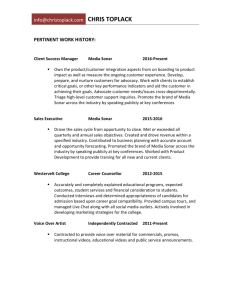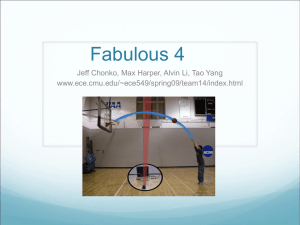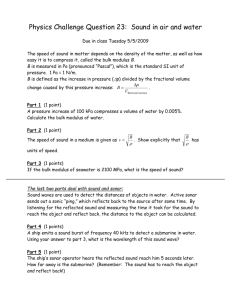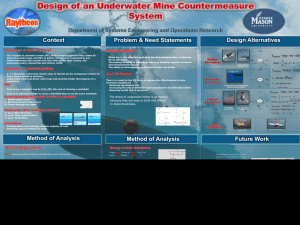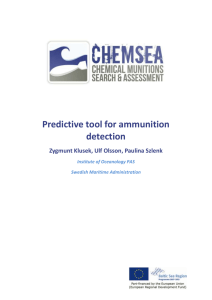Siamak Khaledi Hari Mann James Perkovich Samar Zayed
advertisement
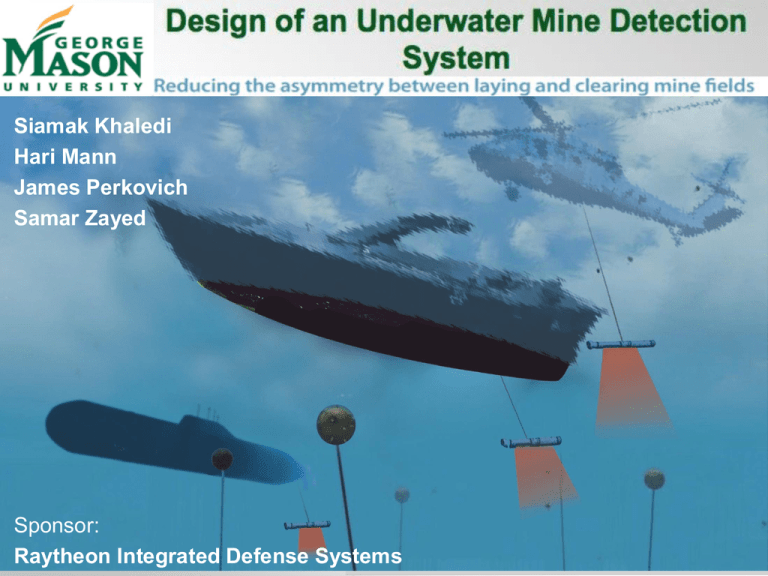
1 Siamak Khaledi Hari Mann James Perkovich Samar Zayed Sponsor: Raytheon Integrated Defense Systems Importance of Maritime Travel 90% of global commerce is conducted by sea Inland waterways link coastal cities to the open ocean Heavy commercial and military traffic The mission of the Navy is to maintain, train and equip combat-ready naval forces capable of winning wars, deterring aggression and maintaining freedom of the seas. Underwater mines severely hinder the progress of naval fleet 2 (Wired) Underwater Mines Types • Sea floor/Bottom • Floating/Surface • Moored, etc. Sensing Techniques • • • • Contact Acoustic Pressure Magnetic, etc. (21st Century U.S. Navy Mine Warfare) Damage • Warheads can weigh between 100 and 700+ kg • 1991: USS Tripoli struck a contact mine 3 (NOAA) Current Detection Process Current System • Manned Helicopter • Towing sonar Sonar Operation Procedure • Sends out sound waves • Receives sound wave echoes • Towed through the water 4 Active Sonar Equation All terms in dB Detection if SE ≥ 0 𝑳𝒔 : Source level radiated by and measured at sonar 𝑵𝒘 : Propagation loss en route to receiver 𝑻𝑺 : Target strength (measure of sound reflected by target) 𝑳𝑵 : Sonar self-noise 𝑨𝑮 : Array gain (how much noise the array cuts out) 𝑫𝑻 : Detection threshold (Signal to Noise Ratio (SNR) required for detection) 5 𝑺𝑬 : Signal excess (Processed SNR) Stakeholder Interactions Concern over environmental impact Beneficiaries Concern over new procedures 2. Need for action System Customers 1. Mine laying 3. Need for system Minelayers Designers & Manufacturers System Operators 5. Countermeasure SYSTEM Environmental impact New procedures Cost Environmental Groups 4. Create system Servicemen Taxpayers Concern over value of investment Primary Intended interaction Secondary 6 Tertiary Indirect impact Response to impact Problem / Need Problem: Mines are a very effective method of blocking shipping lanes, restricting Naval operations. The placing of mines in waterways can have severe negative economic and environmental impact. Time required to clear a mine field can be up to 200 times the time required to place the minefield. Cost to lay a minefield can be as low as 0.5% of the cost required to clear a minefield. Need: There is a need for the U.S. Navy to improve the effectiveness of mine clearance systems. •Reduce operational cost •Increase the rate of detection and neutralization of underwater mines •Remove safety risk of personnel 7 Mission Requirements System Requirements Cost Requirements • Fuel cost to search 1 square mile shall be less than $62.15 System shall require fewer than 5 people to operate Vehicle acquisition cost shall be minimized Sonar acquisition cost shall be minimized • • • Performance Requirements • • • • • 8 Sonar shall be able to search a • width of 300 meters System shall have endurance greater than 2 hours • Vehicle shall accelerate to a velocity of 12 knots System shall be transportable on current Navy ships Probability of false detection shall be less than 0.5% Safety Requirements System operators shall be protected from mine explosions Environmental impact shall be minimized Design Alternatives: Sonar 9 Small Large Example: Klein/L-3 5900 Example: Raytheon AN/AQS-20A Speed: up to 12 knots Weight: 360 lbs. Length: 7.75 ft. Diameter: 8 in Speed: 10 to 12 knots Weight: 975 lbs. Length: 10.5 ft. Diameter: 15.5 in ~$1M ~$11.83M Design Alternatives: Vehicle Air Surface Submersible Small Large Small Large Ex: K-Max Ex: Fire Scout Ex: Hammerhead Ex: Fleet Class CUSV (Lockheed Martin) (Northrop Grumman) (Meggitt Training Systems) (AAI/Textron) Ex: RMMV (Lockheed Martin) Weight: 5,145 lbs. Weight: 6,000 lbs. Weight: 1,984 lbs. Weight: 22,000 lbs. Length: 23 ft. Lift capacity: 6,000 lbs. Lift capacity: 2,650 lbs. Length: 17 ft. Length: 39 ft. Diameter: 4ft. Beam: 4.7 ft. Beam: 10.25 ft. Weight: 14,500 lbs. Endurance: 8 hours at 20 knots Draft: 2 ft., 2 in. Speed: >16 knots Range: 1,200 NM Operating Depth: 10200 ft. Flight endurance: 23 hours Flight endurance: 5-8 hours ~$5.1M ~$18.4M ~$100K 10 ~$12M Simulation Objectives/Assumptions Objectives Predict cost of mine detection operations Assumptions Pre-determined area Moored mines only Predict system performance Overt operation Detection only (no neutralization) Urgent clearance Sea state 0 11 Model Inputs/Outputs 12 Submersible Alternative buoyancy drag F Propulsion 𝜃 tow mg (drag due to water resistance) 13 Surface Alternative buoyancy F Propulsion drag 𝜃 mg (drag due to air and water resistance) 14 tow Airborne Alternative lift F Propulsion 𝜃 drag tow mg (drag due to air resistance) * 15 *Principles of Helicopter Aerodynamics, J. Leishman Drag Equation Data Component Sonar Drag Coefficient (C) Large 0.295 [37] 4.08[20] wetted Small 0.295 [37] 1.52[32] wetted 0.04 [36] 58.37 [28] wetted Small (Air portion) 0.7 [37] 1.68 [33] frontal Small (Water portion) 0.12 [37] 14.04 [33] wetted Large (Air portion) 0.7 [37] 5.71 [26] frontal Large (Water portion) 0.12 [37] 34.25 [26] wetted Small 1.35[31] 15.58 [35] frontal Large 1.35[31] 4.77 [30] frontal Underwater Vehicle Surface Vehicle Air Vehicle 16 Area (m2) Alternative Density of water: 1027 kg/m3 Density of air: 1.225 kg/m3 Energy to Cost Calculation Cost per Volume Energy Density . Energy Density : • Diesel = 128,450 BTU/gal.[38] • Gasoline = 116,090 BTU/gal.[38] • Jet Fuel = 125,217 BTU/gal.[8] 17 Fuel Price: $3.873/gal.[15] $3.296/gal.[15] $2.966/gal.[16] Processed SNR 𝑳𝒔 − 𝟐𝑵𝒘 + 𝑻𝑺 − 𝑳𝑵 − 𝑨𝑮 Parameter 18 − 𝑫𝑻 = 𝑺𝑬 Description Large sonar (dB) Small sonar (dB) Source Level 212 197 Propagation Loss Normal(70,12) Normal(70,12) Target Strength 15 15 Noise Level Normal(58,12) Normal(58,12) Array Gain 15 13.6 Detection Threshold 14 14 Naval Operations Analysis (Wagner et al) Gaussian distribution Case Study: Inland Waterway (Google Maps) Mouth of the Chesapeake Bay 3rd and 4th largest ports on East Coast • Hampton Roads • Baltimore Homeports to 69 Navy ships • 2 spans of tunnel • Each 1 mile wide 19 (NOAA Nautical Chart 12222) Design of Experiment Inputs Sonar Vehicle 1 Airborne Large Surface Alternatives 4 5 Small Large Small Airborne 7 9 Large Submersible 6 8 Energy Time P(Detection) Small 2 3 Output Small Surface Large Small Large 10 Submersible 11 Baseline: Seahawk helicopter with Raytheon sonar 20 Fuel Burn Results Sonar 1 square mile travel Vehicle Avg Gallons of Fuel Avg Fuel Cost Rank 4.457 $13.22 4 6.168 $18.30 8 5.021 $16.55 7 9.210 $30.36 10 3.617 $14.01 5 3.242 $9.62 2 Large 4.958 $14.71 6 Small 3.672 $12.10 3 7.887 $26.00 9 2.458 $9.52 1 21.032 $62.38 11 Small Large Large Vehicle Type Air Small Large Surface Underwater Small Small Air Surface Large Underwater Baseline: Seahawk helicopter with Raytheon sonar 21 Small sonar dominant using all vehicles Underwater option consumes least amount of fuel Small sonar/Underwater vehicle has the best fuel economy 800 700 600 500 400 300 200 100 0 𝝁𝑺𝑬 = 30 𝝁𝑺𝑬 = 𝟏𝟑 10,000 replications • • 95% Confidence Interval 1% half width 𝒛𝜶/𝟐 22 Small Sonar 69% SE≥ 𝟎 Signal Excess (dB) Large Sonar 87% SE≥ 𝟎 -150 -140 -130 -120 -110 -100 -90 -80 -70 -60 -50 -40 -30 -20 -10 0 10 20 30 40 50 60 70 80 90 100 110 120 130 140 150 Number of Occurances Processed SNR 𝒑(𝟏 − 𝒑) 𝒏−𝟏 𝒛.𝟎𝟐𝟓 .𝟖𝟕𝟏 (.𝟏𝟐𝟗) 𝟏𝟎𝟎𝟎𝟎−𝟏 = .66% < 1% 𝒛.𝟎𝟐𝟓 .𝟔𝟖𝟗 (.𝟑𝟏𝟏) 𝟏𝟎𝟎𝟎𝟎−𝟏 = .91% < 1% P(Detection) Results P(False Alarm) = 0.5% 𝜇𝑆𝐸 (Small) = 13, 𝜇𝑆𝐸 (Large) = 30 P(Detection) = 0.82 Large sonar: Probability of False Alarm, percent Probability of False Alarm, percent (Principles of Underwater Sound, R.J. Urick) 23 P(Detection) = 0.998 Probability of Detection, percent Probability of Detection, percent Small sonar: Value Hierarchy Utility Process Time .56 24 P(Detection) .28 Safety .11 Fuel Burn .05 Life Cycle Cost Life Cycle Cost • Acquisition • Operational cost • Staffing requirements Assumptions • 1 Mine detection operation every 2 weeks for 20 years • 5 square mile operation Staffing requirements • SH-60S Seahawk – 2 pilots, 2 air crew • Unmanned vehicles – 1 person • Sonar – 1 person 25 Utility vs. Cost Analysis Utility 0.5 Small Sonar, Small Boat 0.45 0.4 Small Sonar, Small Helicopter 0.35 Small Sonar, Large Helicopter 0.3 Small Sonar, Underwater Vehicle 0.25 Large Sonar, Small Boat 0.2 Large Sonar, Small Helicopter 0.15 Large Sonar, Large Helicopter 0.1 Large Sonar, Underwater Vehicle 0.05 Current System 0 0.00 10.00 20.00 30.00 40.00 50.00 Cost ($ million) The Small sonar offers a cheaper alternative but the utility of the Large sonar is higher. • Small sonar, Small boat: Utility = .158, Cost = $3.5M • Large sonar, Small boat: Utility = .433, Cost = $14.4M • Marginal cost of utility: $3,942,389 / .1 units of utility 26 Additional Alternatives •Improved P(D) •Same Process Time •2x Fuel Burn •Same P(D) •½ Process Time •Same Fuel Burn •Improved P(D) •½ Process Time •2x Fuel Burn Improved P(D): New P(D) = P(D) + [(1-P(D))*P(D)] = 0.82 + [(1-0.82)*0.82] = 0.968 27 Utility vs. Cost Analysis (2) Utility 1 0.9 0.8 Small Sonar, Small Boat 0.7 Large Sonar, Small Boat 0.6 0.5 Current System 0.4 2x (Time Emphasis) 0.3 2x (Detection Emphasis) 0.2 4x 0.1 0 0.00 10.00 20.00 30.00 40.00 50.00 Cost ($ million) 2x Small sonar, Small boat (Time emphasis): • Utility = .718, Cost = $7.03M 2x Small sonar, Small boat (Detection emphasis): • Utility = .378, Cost = $7.06M 4x Small sonar, Small boat: 28 • Utility = .938, Cost = $14.06 Sensitivity Analysis Utility Process Time .56 29 P(Detection) .28 Safety .11 Fuel Burn .05 Recommendations Utility Improvement over current system Cost Savings over current system 2x Small sonar, Small boat (time emphasis) .718 156% $7.03M $39.76M 4x Small sonar, Small boat .938 235% $14.06M $32.73M Alternative 30 Questions 31 References 1. 2. 3. 4. 5. 6. 7. 8. 9. 10. 11. 12. 13. 14. 15. 16. 17. 18. 19. 20. 21. 22. 23. 24. 25. 26. 27. 28. 29. 30. 31. 32. 33. 34. 35. 36. 37. 38. R. J. Urick, Principles of Underwater Sound, 3rd ed., Peninsula Publishing, USA, 1983. D. Wagner et al, Naval Operations Analysis, 3rd ed., Naval Institute Press, Annapolis, MD, 1999. N/A, “Q-20 Mine Reconnaissance Testing” noaa.gov [Online] Available: http://www.nmfs.noaa.gov/pr/pdfs/permits/nswc_pcd_ea2012.pdf [Accessed: 3/25/2014]. N/A, “Selected Acquisition Report (SAR)” dod.mil [Online] Available: http://www.dod.mil/pubs/foi/logistics_material_readiness/acq_bud_fin/SARs/DEC%202011%20SAR/RMS%20-%20SAR%20%2031%20DEC%202011.pdf [Accessed: 2/18/2014]. N/A, “Hammerhead USV-T” [Online] Available: http://www.navaldrones.com/Hammerhead.html [Accessed: 2/18/2014]. N/A, “Kaman K-Max” [Online] Available: http://www.aircraftcompare.com/helicopter-airplane/Kaman-K-Max/426 [Accessed: 2/18/2014]. J. K. Oestergaard, “About the MQ-8 Fire Scout” [Online] Available: http://www.bga-aeroweb.com/Defense/MQ-8-Fire-Scout.html [Accessed: 2/18/2014]. M. Janic, Greening Airports: Advanced Technology and Operations, Springer, Delft, Netherlands, 2011. N/A, “Littoral Combat Ship (LCS)” [Online] Available: http://www.naval-technology.com/projects/littoral/ Accessed: 2/11/2014]. N/A, “SH-60 Seahawk Helicopter” navy.mil [Online] Available: http://www.navy.mil/navydata/fact_display.asp?cid=1200&tid=500&ct=1 [Accessed: 11/11/2013]. T. Garrison, Essentials of Oceanography, 6th ed., Cengage Learning, Belmont, CA, 2011. M. Mitchell. (2014, Feb. 12). L-3 Communications [Online]. Available e-mail: Michael.mitchell@l-3com.com Message: RE: Request for Information about Klein System 5900 N/A, “AN/AQS-20A” [Online] Available: http://www.deagel.com/Helicopter-Warners-and-Sensors/ANAQS-20A_a001375001.aspx [Accessed: 2/18/2014]. N/A, “Lethal Sounds” [Online] Available: http://www.nrdc.org/wildlife/marine/sonar.asp [Accessed: 09/25/2013]. N/A, “Gasoline and Diesel Fuel Update” [Online] Available: www.eia.doe.gov/petroleum/gasdiesel/ [Accessed: 2/6/2014]. N/A, “Fuel Price Analysis” [Online] Available: https://www.iata.org/publications/economics/fuel-monitor/Pages/price-analysis.aspx [Accessed: 2/6/2014]. N/A, “Port Industry Statistics” [Online] Available: http://web.archive.org/web/20070104212555/http:/www.aapa-ports.org/Industry/content.cfm?ItemNumber=900&navItemNumber=551 [Accessed: 09/28/2013]. N/A, “The US Navy – Home Ports and the Ships Assigned” navi.mil [Online] Available: http://www.navy.mil/navydata/ships/lists/homeport.asp [Accessed: 09/28/2013]. N/A, “NOAA Nautical Chart 12222” oceangrafix.com [Online] Available: http://www.oceangrafix.com/chart/detail/12222-Chesapeake-Bay-Cape-Charles-to-Norfolk-Harbor [Accessed: 09/28/2013]. N/A, “AN-AQS-20A Minehunting Sonar System” [Online] Available: http://www.raytheon.com/ourcompany/rtnwcm/groups/public/documents/datasheet/an_aqs_20_minehunting.pdf [Accessed: 09/07/2013]. N/A, “21st-Century U.S. Navy Mine Warfare” [Online] Available: http://www.navy.mil/n85/miw_primer-june2009.pdf [Accessed: 09/21/2013]. M. Sadraey, Aircraft Performance Analysis, VDM Publishing, Saarbrucken, Germany, 2011. N/A, “Chesapeake Bay Bridge-Tunnel – Facts & Figures” [Online] Available: http://www.cbbt.com/facts.html [Accessed: 10/22/2013]. J. Hudson, “The Navy is Depending on Dolphins to Keep the Strait of Hormuz Open” [Online] Available: http://www.theatlanticwire.com/global/2012/01/militarys-weapon-against-iranian-mines-high-tech-dolphins/47384/ [Accessed: 10/06/2013]. G. Robbins, “Navy to cut back use of mine-detecting dolphins” [Online] Available: http://www.utsandiego.com/news/2012/Nov/24/navy-stop-training-military-dolphins-san-diego/ [Accessed: 10/06/2013]. N/A, “Performance, Persistence & Modularity” [Online] Available: http://www.aaicorp.com/sites/default/files/datasheets/AAI_CUSV_08-08-11_AAI.pdf [Accessed: 10/22/2013]. N/A, “Mine Warfare” navy.mil [Online] Available: http://www.public.navy.mil/surfor/mcmconflict/Pages/minewarfare.aspx [Accessed: 10/22/2013]. N/A, “Remote Multi-Mission Vehicle” navi.mil [Online] Available: http://acquisition.navy.mil/content/download/7880/36392/version/1/file/rmmv+20110812.pdf [Accessed: 10/22/2013]. N/A, “K-MAX Unmanned Aircraft System” [Online] Available: http://www.lockheedmartin.com/content/dam/lockheed/data/ms2/documents/K-MAX-brochure.pdf [Accessed: 10/22/2013]. N/A, “MQ-8C Fire Scout” [Online] Available: http://www.northropgrumman.com/Capabilities/FireScout/Documents/pageDocuments/MQ-8C_Fire_Scout_Data_Sheet.pdf [Accessed: 10/22/2013]. J. Leishman, Principles of Helicopter Aerodynamics, Cambridge University Press, New York, NY, 2006. N/A, “Klein System 5900” [Online] Available: http://www.l-3mps.com/klein/pdfs/Klein_System5900_Nov12_lettersize.pdf [Accessed: 2/3/2014]. N/A, “Hammerhead Brochure March 13” [Online] Available: http://www.meggittcanada.com/media/public_files/documents/2013/Mar/15/Hammerhead_Brochure_March13.pdf [Accessed: 10/22/2013]. N/A, “Privacy Policy” navi.mil [Online] Available: http://www.navi.mil [Accessed: 11/12/2013]. N/A, “KMAX Flight Manual” kaman.com [Online] Available: http://www.kaman.com/files/file/PDFs/Helicopter%20PDFs/KMAX_Flight_Manual.pdf [Accessed: 3/18/2014]. N/A, “Shape Effects on Drag” nasa.gov [Online] Available: http://www.grc.nasa.gov/WWW/k-12/airplane/shaped.html [Accessed: 1/10/2014]. N/A, “Drag Coefficient” [Online] Available: http://www.engineeringtoolbox.com/drag-coefficient-d_627.html [Accessed: 3/18/2014]. N/A, “Alternative Fuels Data Center – Fuel Properties Comparison” energy.gov [Online] Available: http://www.afdc.energy.gov/fuels/fuel_comparison_chart.pdf [Accessed: 1/10/2014]. 32
